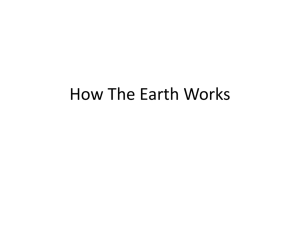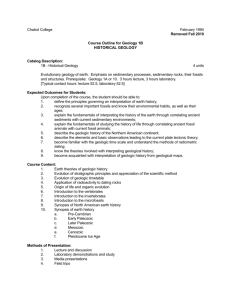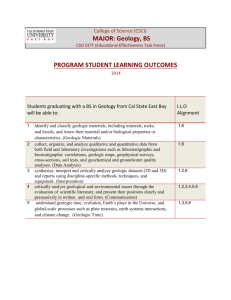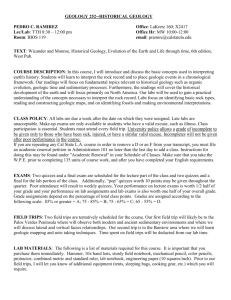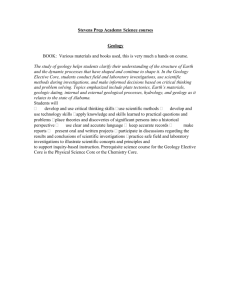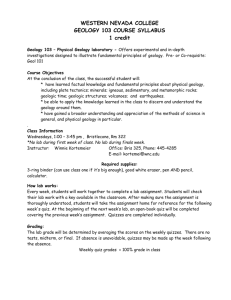GE 218 Structural Geology & Tectonics Syllabus S2002
advertisement
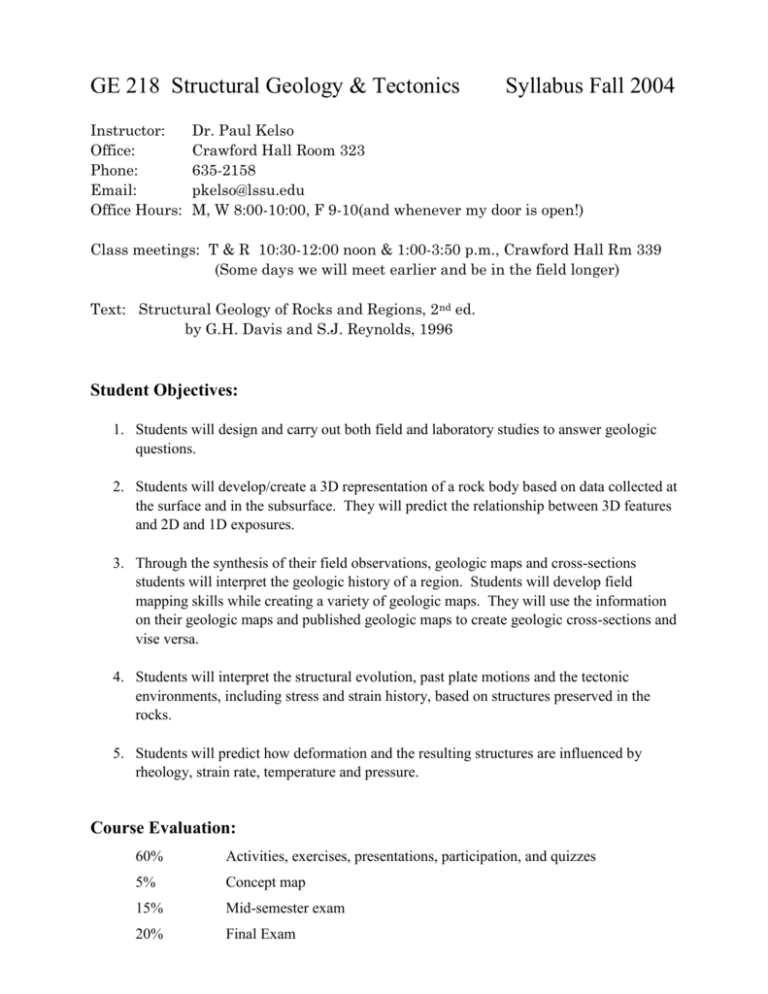
GE 218 Structural Geology & Tectonics Instructor: Office: Phone: Email: Office Hours: Syllabus Fall 2004 Dr. Paul Kelso Crawford Hall Room 323 635-2158 pkelso@lssu.edu M, W 8:00-10:00, F 9-10(and whenever my door is open!) Class meetings: T & R 10:30-12:00 noon & 1:00-3:50 p.m., Crawford Hall Rm 339 (Some days we will meet earlier and be in the field longer) Text: Structural Geology of Rocks and Regions, 2nd ed. by G.H. Davis and S.J. Reynolds, 1996 Student Objectives: 1. Students will design and carry out both field and laboratory studies to answer geologic questions. 2. Students will develop/create a 3D representation of a rock body based on data collected at the surface and in the subsurface. They will predict the relationship between 3D features and 2D and 1D exposures. 3. Through the synthesis of their field observations, geologic maps and cross-sections students will interpret the geologic history of a region. Students will develop field mapping skills while creating a variety of geologic maps. They will use the information on their geologic maps and published geologic maps to create geologic cross-sections and vise versa. 4. Students will interpret the structural evolution, past plate motions and the tectonic environments, including stress and strain history, based on structures preserved in the rocks. 5. Students will predict how deformation and the resulting structures are influenced by rheology, strain rate, temperature and pressure. Course Evaluation: 60% Activities, exercises, presentations, participation, and quizzes 5% Concept map 15% Mid-semester exam 20% Final Exam You will need the following materials. Bring them with you to each class meeting! Davis and Renyolds (1996) Structural Geology of rocks and regions, 2nd ed. Pencil and eraser (preferably 0.5 mm with a fairly hard lead) straightedge protractor (smaller is better) colored pencils sharpie markers and sample bags (e.g., freezer Ziploc bags) field book (the geology club has them available) hand lens - 10x triplet lens (order through the geology club) map board (coordinate as a class or through the geology club) Course Format: This course will concentrate on field geology, structural geology and tectonics. This semester we will be doing geology. Having me talk at you hour after hour allows me to present material but it doesn’t necessarily provide you with the best opportunity to learn. We will spend the semester doing geology as opposed to listening to me talk about it. Therefore, I place a great deal of the responsibility on you. After all, I can’t do your learning for you. One of your responsibilities is to come to class and be prepared to participate. We will do a number of activities, projects, experiments, many of which will involve group work with each individual having particular responsibilities that must be completed in advance of class. Thus, it is expected that you will be present for all class meetings unless you have made prior arrangements. In the unforeseen emergency where you do miss a class it is your responsibility to do what you need to do to catch up. FIELD TRIPS: We are fortunate to have a diversity of geologic features exposed in our region and because we are going to do geology, we will go on a number of field trips. Field trips are generally scheduled for Tuesdays and Thursdays. Approximately one field trip a week is planned for the first half of the semester but trip schedules are somewhat weather dependent. Field trips will range from a short excursion around campus to an all day trip. I will let you know in advance when we are going out and how long we will be gone. It is your responsibility to be on time and be adequately dressed and prepared for all field trips. You will need sturdy shoes and clothes that you don’t mind getting dirty, water (2 liters or more), food (snacks/meals), your field book and hand lens. Sack lunches can be ordered in advance from the quarterdeck. We will take advantage of our unique locale to participate in a variety of different types of geological studies. What a great place to do geology! Your other responsibility is to complete your homework and hand it in on time. You will often be working together as groups and I encourage you to discuss the material with others. But I expect you will do your own work and will not copy others. When the time comes that you must do your own work (for example on an exam or in the work place) you will be at a distinct disadvantage if you have not learned how to do it yourself. I hear, and I forget. I see, and I remember. I do, and I understand. GE 218 - Structural Geology & Tectonics Fall 2004 Course Activities / Topics: (in approximate order, order will vary and some topics will be revisited multiple times as they are presented in the context of individual projects) Primary and secondary features of rocks Geologic time 3D visualization Introduction to geologic field techniques Geologic maps Geologic cross sections Brittle processes Joints Faults Folds Stress Strain Mohr – Coulomb failure Subsurface maps Fold mechanisms Stereonets Anderson’s theory of faulting Ductile processes Foliations Lineations Plate tectonics Strain Pure and Simple shear Tectonic motions Disability Services and Accommodations for Students. In compliance with Lake Superior State University policy and equal access laws, disabilityrelated accommodations or services are available. Students who desire such services are to meet with the professor in a timely manner, preferably the first week of class, to discuss their disability-related needs. Students will not receive services until they register with the Resource Center for Students with Disabilities (RCSD). Proper registration will enable the RCSD to verify the disability and determine reasonable academic accommodations. RCSD is located in KJS Library Room 101. The telephone number is (906) 635-2454.

